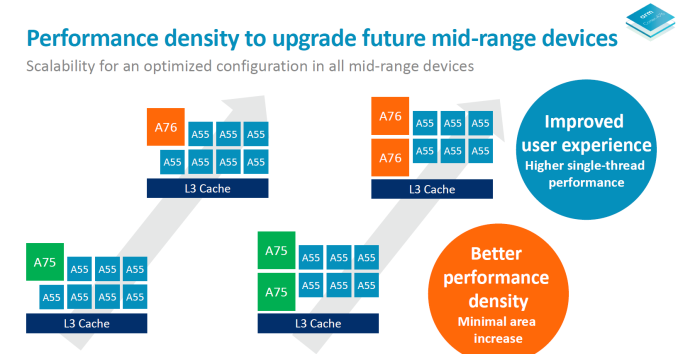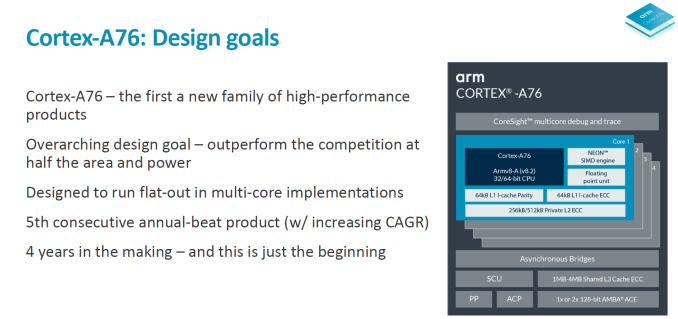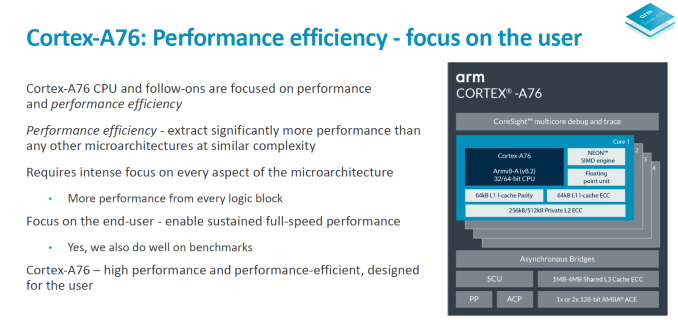Arm's Cortex-A76 CPU Unveiled: Taking Aim at the Top for 7nm
by Andrei Frumusanu on May 31, 2018 3:01 PM EST- Posted in
- CPUs
- Arm
- Smartphones
- Mobile
- SoCs
- Cortex-A76

Another year, another TechDay from Arm. Over the last several years Arm’s event has come as clockwork in the May timeframe and has every time unveiled the newest flagship CPU and GPU IPs. This year is no exception as the event is back on the American side of the Atlantic in Austin Texas where Arm has one of its major design centres.
Two years ago during the unveiling of the Cortex A73 I had talked a bit more about Arm’s CPU design teams and how they’re spread across locations and product lines. The main design centres for Cortex-A series of CPUs are found in Austin, Texas; Cambridge, the United Kingdom, and Sophia-Antipolis in the south of France near Nice. For the last two years the Cortex A73 and Cortex A75 were designs that mainly came out of the Sophia team while the Cortex A53 and more recently the A55 were designs coming out of Cambridge. This means that we haven’t seen any recent designs coming out of Austin and the last of the “Austin family” of CPUs were the A57 and A72.
The project being worked on in Austin had been hyped up for several years – I remember even as early as the A73 release back in 2016 the company had pulled forward some elements from an advanced future microarchitecture on the back-end pipelines, especially on the FP/SIMD side. The Cortex A75 was further remarked as pulling more elements from this new mysterious project.
Today we can finally unveil what the Austin team has been working on – and it’s a big one. The new Cortex A76 is a brand new microarchitecture which has been built from scratch and lays the foundation for at least two more generations for what I’ll call “the second generation of Austin family” of CPUs.
The Cortex A76 is important for Arm for a design perspective as it represents a new start from a clean sheet. It’s rare for IP claim to be able to do this as it represents a great resource and time investment and if it weren’t for the Sophia design team taking over the steering wheel for the last two generations of products it wouldn’t have been reasonable to execute. The execution of the CPU design teams should be emphasised in particular as Arm claims this is the 5th generation “annual beat” product where the company delivers a new microarchitecture every new year. Think of it as an analogue to Intel’s past Tick-Tock strategy, but rather Tock-Tock-Tock for Arm with steady CAGR (compound annual growth rate) of 20-25% every generation coming from µarch improvements.
So what is the Cortex A76? In Arm’s words, it’s a “laptop-class” performance processor with mobile efficiency. The vision of the A76 as a laptop-class processor had been emphasised throughout the TechDay presentation so it seems Arm is really taking advantage of the large performance boost of the IP to cater to new market segments such as the emerging “Always connected PCs” which Qualcomm is spearheading with their SoC platforms.
The Cortex A76 microarchitecture has been designed with high performance while maintaining power efficiency in mind. Starting from a clean sheet allowed the designers to remove bottlenecks throughout the design and to break previous microarchitectural limitations. The focus here was again maximum performance while remaining within energy efficiency that is fit for smartphones.
In broad metrics, what we’re promised in actual products using the A76 is the follows: a 35% performance increase alongside 40% improved power efficiency. We’ll also see a 4x improvements in machine learning workloads thanks to new optimisations in the ASIMD pipelines and how dot products are handled. These figures are baselined on A75 configurations running at 2.8GHz on 10nm processes while the A76 is projected by Arm to come in at 3GHz on 7nm TSMC based products.
The new CPU is naturally still compatible with DynamIQ’s common cluster topology and Arm envisions designs to be paired with Cortex A55s as the little more power efficient CPUs. The configuration scalability of the DynamIQ IP again was reiterated and we were presented with example configurations such as 1+7 or 2+6 with either Cortex A75 or A76 CPU IP. This presentation slide was one of the rare ones where Arm referred to the area size of the A76, pointing out that the A75 still had better PPA and thus might still be a valid design choice for companies, depending on their needs. One comparison that was made during the event is that in terms of area, three A76’s with larger caches would fit inside the size of a Skylake core – all while within 10% of the IPC of the Intel CPU, but obviously there’s also process node scaling considerations to take into account.
A standout claim is that Arm aims to outperform the competition at half the area and half the power. Arm was slightly beating around the bush here in what it considers the competition, but generally the answer was that it was considering everybody the competition. Taking into account Intel, AMD or Samsung it’s actually not that hard to imagine Arm beating them in PPA as historically the company always had the smallest CPU designs and that directly translates into more efficient microarchitectures.
Before we get into more detailed breakdowns of the performance and power improvements and what I’m expecting to happen into products, let’s see the microarchitectural improvements on the core and how Arm managed to extract this much performance while maintaining power efficiency.















123 Comments
View All Comments
leo_sk - Sunday, June 3, 2018 - link
They had many problems other than target audience. I can give one plus as a counter exampleMatthmaroo - Monday, June 4, 2018 - link
Also Apple has gigantic RD budgetsThink Intel / Qualcomm and AMD are a faction of Apple is size
Matthmaroo - Monday, June 4, 2018 - link
Edit “is” should be ApplesAnd add ARM holding to the list of cpu developers
BillBear - Friday, June 1, 2018 - link
We know from TSMC that moving the A12 to their 7nm process will give Apple some significant improvements before we even consider this year's improvements to their design.>Compared to its 10nm FinFET process, TSMC's 7nm FinFET features 1.6X logic density, ~20% speed improvement, and ~40% power reduction.
http://www.tsmc.com/english/dedicatedFoundry/techn...
joms_us - Friday, June 1, 2018 - link
Nonsense, GB was designed to interpolate scores from worthless tasks that don't mean to real-world scenarios. Even iPhone with A11 is no match in speed and performance versus SD845 and Exynos powered Android phones today. You only use GB to compare two similar platform period. There is no way in hell A11 is faster than Skylake or Ryzen. Only ret@rded people will believe on that.BillBear - Friday, June 1, 2018 - link
>GB was designed to interpolate scores from worthless tasksGeekbench borrows code from popular open source projects and benchmarks that code running against the same workload on multiple platforms.
For instance, Google's open sourced code to render HTML and DOM in Chrome, Google's code to render PDFs in Chrome, the open sourced LLVM compiler Google now builds the Windows version of Chrome with.
Hardly worthless.
joms_us - Friday, June 1, 2018 - link
Oh yeah rendering html, see any speed tests, SD845 phone loads faster than iPhone 8/X. SD845 exports video faster than A11. See my point, just because A9 loads one piece of the whole feature, doesn't mean it it has faster single core than even SD820 which used to have higher score than A9 using prev GB version. See the point? They rigged the scoring system so it would appear Apple SoC is much faster than even Intel or AMD processors LOL.name99 - Friday, June 1, 2018 - link
Comparing Apple cores to Intel for browsers gives the same results as GeekBench.My personal comparisons of Wolfram Player on iPad Pro vs MacBook Pro again confirm GB4 results.
Back when we had SPEC2006 numbers for Apple cores, YET AGAIN they confirmed the GB4 results...
If you don't believe the browser results, nothing is stopping you from running something like jetstream on your own devices (and borrowing someone's iPad Pro or iPhone X, since I assume you wouldn't be caught dead owning one).
https://www.browserbench.org/JetStream/
joms_us - Friday, June 1, 2018 - link
Good now load a similar app and website at the same time on iPhone X and AMD or Intel desktop and come back here. Even SD835 slaughtered the A11 on a side by side comparisons. Again the point is, they multiplied the scores on where Apple SoC is faster by nanosec and call it twice faster than competiton LOL. As if nanosec is noticeable in real life scenario =Dlostmsu - Tuesday, June 5, 2018 - link
You are being unreasonable. Run JetStream on any of your SD8XX devices, and let parent run it on A11, and let's see. Nobody's going to trust your word here against a reasonable suggestion.